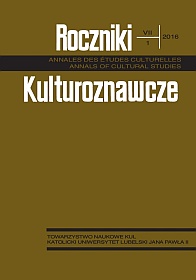The Use of Quantitative Analysis of Digitised Newspapers to Challenge Established Historical Narratives
Abstrakt
Użycie analizy ilościowej zdigitalizowanych czaopism do zmiany ustalonych narracji historycznych
W niniejszym artykule przedstawiono zalety użycia ilościowej analizy cyfrowych źródeł pierwotnych w badaniach historycznych, wskazując, w jaki sposób może ona kwestionować przyjętą ortodoksyjność i tworzyć nowe wglądy. Autor użył bazy danych cyfrowych wersji brytyjskich czasopism faszystowskich z lat trzydziestych XX wieku w celu stworzenia dużej, spójnej i miarodajnej próby faszystowskiego dyskursu we wspomnianym okresie. Używając metody kodowania, zarejestrował wszystkie wzmianki o Żydach występujące w tej próbie. Umożliwiło mu to prześledzenie w czasie rozwoju antysemityzmu faszystów w kontekście jego ilości, typologii i uwydatnienia w dyskursie. Użyta metoda – w połączeniu z bardziej tradycyjną analizą źródeł –kwestionuje różne przyjęte i powszechnie uznawane aspekty właściwej historiografii. W szczególności, przedstawia on, że dotychczasowa jednomyślność historyków dotycząca chronologii rozwoju antysemityzmu brytyjskich faszystów jest błędna. W jej miejsce proponuje nowy, pięciostopniowy model jego rozwoju. Dokładniejsza linia czasu pozwala mu w bardziej przejrzysty sposób wyjaśnić motywy i ideologię przyświecającą stosunkowi faszystów do Żydów.
Bibliografia
Alderman, Geoffrey. Modern British Jewry. Oxford: Oxford University Press, 1998.
Anderson, Margo. “Quantitative History.” In The Stage Handbook of Social Science Methodology, edited by William Outhwaite and Stephen Turner. London: Sage Publications, 2007.
Antisemitism in the Modern World, edited by Richard Levy. Massachusetts: Heath and Co., 1991.
Arendt, Hannah. The Origins of Totalitarianism. London: Andre Deutsch, 1986.
Baldoli, Claudia “Anglo-Italian Fascist Solidarity?: The Shift from Italophobia to Naziphilia in the BUF.” In The Culture of Fascism: Visions of the Far Right in Britain, edited by Thomas Linehan and Julie Gottlieb. London: IB Tauris, 2004.
Bauer, Yehuda. “In Search of a Definition of Antisemitism.” In Approaches to Antisemitism: Context and Curriculum, edited by Michael Brown. New York: The American Jewish Committee, 1994.
Brustein, William I. Roots of Hate: Antisemitism in Europe Before the Holocaust. Cambridge: Cambridge University Press, 2003.
Brewer, John D. Mosley’s Men: The British Union of Fascists in the West Midlands. London: Gower, 1984.
Budge, Ian, Hans-Dieter Klingemann, Andrea Volkens, Judith Bara, and Eric Tanenbaum. Mapping Policy Preferences: Estimates for Parties, Electors, and Governments 1945-1998. Oxford: Oxford University Press, 2001.
Cross, Colin. The Fascists in Britain. London: Barrie and Rockliff, 1961.
Cullen, Stephen M. “Political Violence: The Case of the British Union of Fascists.” Journal of Comtemporary History 28 (1993), 2: 245–67.
Doob, Leonard W. “Ezra Pound Speaking”: Radio Speeches of World War II. Westport: Greenwood, 1978.
Dorril, Stephen. Blackshirt: Sir Oswald Mosley and British Fascism. London: Penguin, 2007.
Ettinger, Samuel. “Jew-Hatred in Historical Context.” In Antisemitism Through the Ages, edited by Shmuel Almog. Oxford: Pergamon Press, 1988.
Evans, Michael, Wayne McIntosh, Jimmy Lin, and Cynthia Cates. “Recounting the Courts? Applying Automated Content Analysis to Enhance Empirical Legal Research.” Journal of Empirical Legal Studies 4 (2007): 1007-39.
Gentzkow, Matthew, and Jesse M. Shapiro. “What Drives Media Slant? Evidence from US Daily Newspapers.” Econometrica 78 (2010): 35-71.
Harap, Louis. Creative Awakening: The Jewish Presence in Twentieth-Century American Literature, 1900s-1940s. Westport: Greenwood, 1987.
Holmes, Colin. Anti-Semitism in British Society 1876-1939. London: Arnold, 1979.
Lewis, David Stephen. Illusions of Grandeur: Mosley, Fascism and British Society, 1931-81. Manchester: Manchester University Press, 1987.
Langmuir, Gavin. Toward a Definition of Antisemitism. Berkeley: University of California Press, 1990
Linehan, Thomas. East London for Mosley: The British Union of Fascists in East London and South-West Essex. London: Frank Cass, 1996.
Linehan, Thomas. British fascism 1918-39: Parties, ideology and culture. Manchester: Manchester University Press, 2000.
Mandle, W.F. Anti-Semitism and the British Union of Fascists. London: Longman, 1968.
Paxton, Robert. The Anatomy of Fascism. London: Penguin, 2004.
Pennings, Paul. “An Empirical Analysis of the Europeanisation of National Party Manifestos, 1960-2003”. European Union Politics 7 (2006): 257-70.
Pugh, Martin. “Hurrah for the Blackshirts”: Fascists and Fascism in Britain Between the Wars. London: Pimlico, 2005.
Skidelsky, Robert. Oswald Mosley. London: Papermac, 1990.
Thurlow, Richard. Fascism in Britain: From Oswald Mosley’s Blackshirts to the National Front. London: IB Tauris, 2006.
Tilles, Daniel. “The Myth of Cable Street”. History Today 61 (2011).
Tilles, Daniel. British Fascist Antisemitism and Jewish Responses, 1932-40. London: Bloomsbury, 2014.
Volkens, Andrea. Manifesto Data Set. MDS 2005 Data Handbook. Berlin: WZB, 2005.
Webber, G.C. “Patterns of Membership and Support for the BUF.” Journal of Contemporary History 19 (1984): 575-606.





